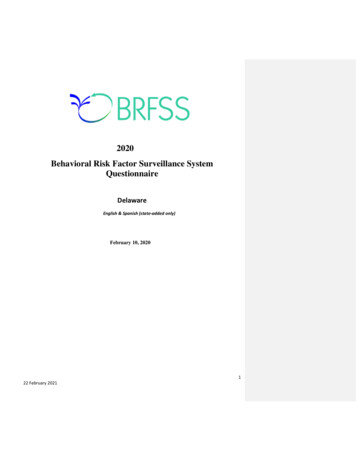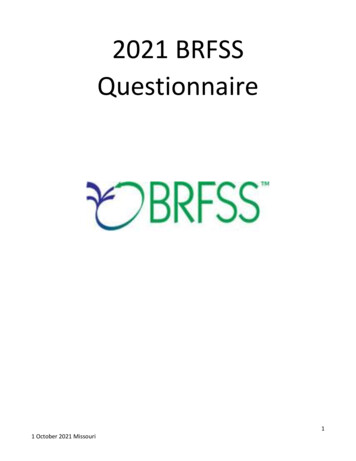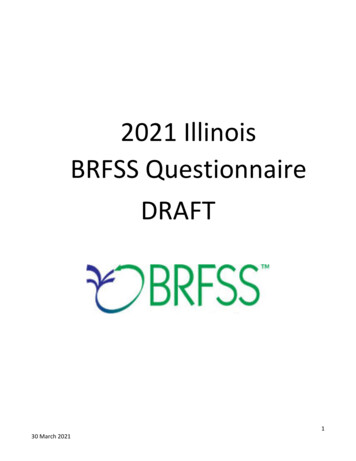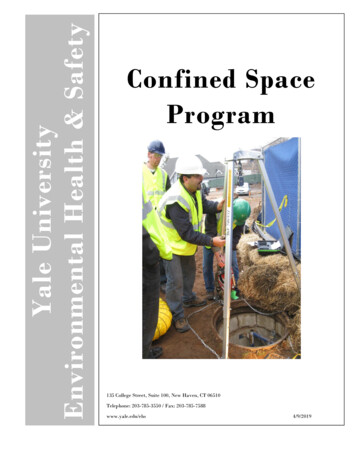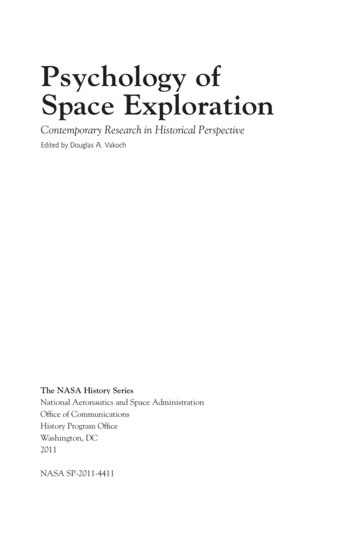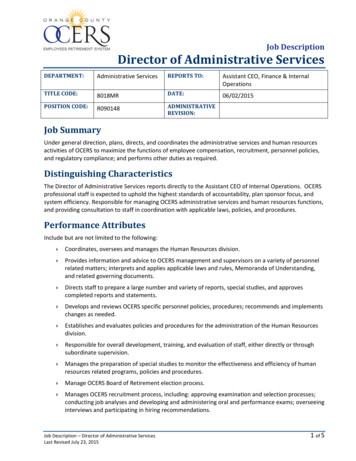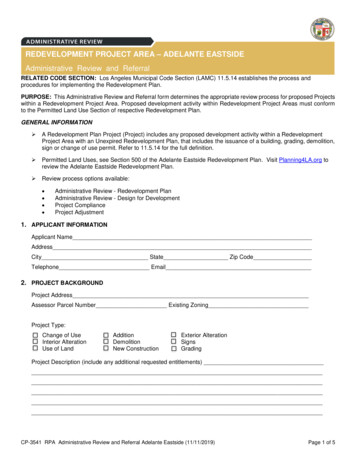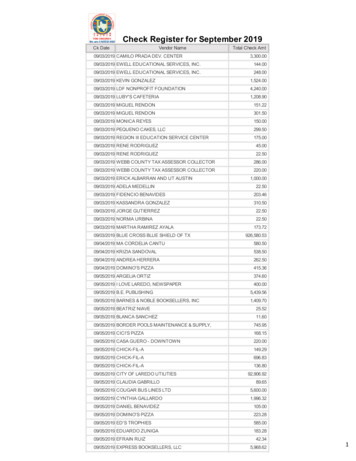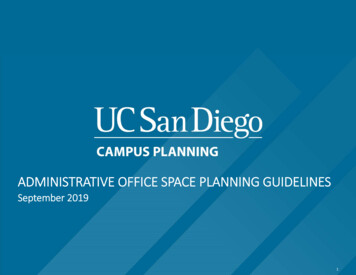
Transcription
ADMINISTRATIVE OFFICE SPACE PLANNING GUIDELINESSeptember 20191
CONTENT STATEMENT OF PURPOSE PLANNING PRINCIPLES PLANNING APPROACH PLANNING EXAMPLES CONCEPT DEFINITIONS GUIDELINES SPACE STANDARDS APPENDIX2
STATEMENT OF PURPOSEUC San Diego is experiencing rapid growth on campus including an increasein student enrollment, new construction such as the North Torrey PinesLiving and Learning Neighborhood, the Triton Pavilion and the new light railsystem coming in 2020. Space for student programs and Administrativeoffice space will continue to be constrained until these new projects arebrought on‐line. In an effort to maximize the efficiency of existingadministrative office space and transform new and renovated workenvironments, new administrative office space planning guidelines are beingimplemented on campus.These planning guidelines encourage a more balanced “Activity‐Based”workplace environment by providing the work space that best supports thework being performed, instead of assigning space by rank or title. Additionalgoals include creating equity of space, with equal access to light and views,providing more shared social spaces and encouraging more collaboration.These planning guidelines are meant to provide a starting point for spaceplanners to determine the amount and types of space needed whendesigning new offices or reconfiguration of existing administrative officespace.These guidelines are voluntary and apply to administrative office space only,and do not include Academic Affairs, Research or lab office designs.UC MERCED ADMINISTRATIVE BUILDINGAdministrative Office Space Planning Guidelines3
PLANNING PRINCIPLESCreate modern space standards that promote flexibility, efficiency andproductivity, while providing appropriate support spaces and amenities that fostercollaboration.1. Provide a variety of private and collaborative space to supportall work modes2. Encourage neighborhood planning concepts to build identity3. Create equity of space4. Provide equitable access to light and views5. Provide more shared social and amenity spaces6. Encourage collaboration7. Create spaces that provide flexibility for reconfiguration8. Support mobile workers and alternative work schedules9. Create spaces that helps to attract and retain employees10. Accommodate all generations within the workplace11. Use modern space planning and density modelsAdministrative Office Space Planning Guidelines4
PLANNING APPROACHThe following planning concepts provide a framework for thinking about thetype of space that is appropriate for your group. These planning concepts can becombined to meet your group’s unique needs.Activity‐Based planning modelo Higher density design with a balance of private, shared andcollaborative spaceso Focus spaces for concentrated worko Collaborative and team based layoutso Supports alternative work schedules and stylesTransitional planning modelo Average density with more Private offices for focus work modeso A blend of Conventional and Activity‐Based approacheso Amenity spaces for focus and social engagementConventional space planning modelo Lower density with a concentration of private offices and focus workmodeso Can include planning concepts from Activity‐Based and Transitionalo Provide collaborative spaces as needed for teamso Requires less communal work spacesAdministrative Office Space Planning GuidelinesExamples of Activity‐Based Planning5
CONCEPTActivity‐Based workplace concepts have been a staple of corporate culturefor years and are increasingly being used in Academic and Institutionalsettings. Activity‐Based workplace design can on principal, reduce theamount of space dedicated to the individual work space, and increase theamount of shared communal and collaborative spaces. This trend has beenaccelerated by the reduced use of printed materials and file storagerequirements. This approach does not necessarily result in an overallreduction in square footage per person since shared amenity spaces add tothe total square footage, however it does provide greater flexibility tochange and adapt the space over time. Developing uniform space planningguidelines can improve equity and ensure flexibility for long‐term growth.There will always be employees who will require a private office for focusedwork, handling confidential materials and meeting with staff. Employeesassigned to more open environment work settings, may sometimes requirea space for more private concentrated work. These requirements can bemet with private “Focus” rooms that can be reserved for heads down workor one on one meetings that require confidentiality. In addition, phonerooms should be provided for private conversations.Activity‐Based workplace concepts along with technology such as laptopsand cell phones can provide an environment where the worker is able tochoose between a variety of work settings. This flexibility increases workersatisfaction, productivity and employee retention. Campus Planning isadvocating the use of Activity‐Based workplace planning principles for bothnew and remodeled administrative space. Campus Planning is available toadvise each VC area for the reuse of space within their area.Administrative Office Space Planning GuidelinesA UC San Diego Administrative Space Management Study was conducted in2018 by an outside consultant, (Gensler) to provide benchmarking studies andrecommend best practices for campus administrative office space. Read a copyhere: lThe Administrative Space Management Study included interviews with key UCSan Diego stake holders, site observations of representative building facilities,and compared them to peer institutions. Key recommendations included;o Create a centralized policy governing administrative spaces, utilizingmodern density and layout benchmarkso Develop and implement standards for workplace technology (e.g. laptops,docking stations, VOIP, wireless, etc.)o Plan and program appropriate support spaces in Activity‐Based workplacelayouts (e.g. amenities, collaboration, phone rooms, etc.)o Leverage the Triton Pavilion as a novel opportunity to discover andimplement new planning practices based on work activities, rather thantitlesThe space planning guidelines herein were developed around: (1) The UC SanDiego Administrative Space Management Study; (2) current industrystandards; (3) benchmarking data from other academic institutions and privateindustry; and (4) programs developed for new projects on campus. OfficeWorkspace refers both to private and shared offices and workstations orcubicles in an open area.6
PLANNING NINGAdministrative Office Space Planning Guidelines7
DEFINITIONSACTIVITY‐BASED WORKPLACEThe UC San Diego Administrative Space Study recommends a balancedActivity‐Based Workplace defined as neighborhoods that are planned tosupport all four work modes, giving people choice in how and where theywork. The study further defines Activity Based workplace;An activity‐based workplace, with a variety of open and closed spacetypes, provides a more balanced work setting that enables both focusand collaboration. This creates an environment where people havemore choice in where to work, improving the employee experience. Amore balanced environment can also create positive cultural impacts,including greater access to leadership, increased awareness, andstronger teams activity‐based work settings can improve theemployee experience by providing greater balance and choice in worksettingsGensler/UCSD Administrative Space Management StudyOpen Collaborative areaAdministrative Office Space Planning GuidelinesSocial Lounge8
DEFINITIONSACTIVITY‐BASED NEIGHBORHOOD CONCEPTAdministrative Office Space Planning Guidelines9
DEFINITIONSWORK MODESThe UC San Diego Administrative Space Study recommends an Activity‐Based workplace defined as neighborhoods that are planned to support allfour work modes, giving people choice in how and where they work.The four work modes are defined as follows;o Focus‐Work involving concentration and attention to a particulartask or project or confidentiality.o Collaboration‐Work with another person or group to achieve agoal.o Socializing‐Work interactions that create common bonds andvalues, collective identity, collegiality and productive relationships.o Learning‐Working to acquire new knowledge of a subject or skillthrough education or experience.CollaborationSocialFocusAdministrative Office Space Planning Guidelines10
DEFINITIONSWORK MODE CHARACTORISTICSAdministrative Office Space Planning Guidelines11
DEFINITIONSWORK MODE SPACE TYPESAdministrative Office Space Planning Guidelines12
GUIDELINESGUIDELINES FOR SPACE ASSIGNMENTTraditional office space allocates private offices at the exterior perimeterof the building with workstations and shared spaces away from thewindows. This creates an inequality in access to light and views. A moreequitable approach would be to provide circulation and open workstationsat the perimeter window walls, and locate offices towards the interior ofthe space to increase access to light and views.A 2012 Space Utilization & Activity Analysis study by Gensler for theUniversity of California Office of the President, reveals the utilization ratefor workstations, offices and shared offices was on average 46%. This oftenmeans that management offices are empty while the occupant is meetingin conference rooms or off site. A manager that is truly a mobile workercould be assigned a smaller touch‐down space. This approach would freeup access to the window, light and views for employees who spend moretime at their desk. This would also allow for workstations, collaboration,and social spaces to be adjacent to the window wall. Enclosed focus spacessuch as offices and larger closed conference rooms could be located awayfrom the windows.FocusExisting space standards assign space based on job title or the legacy spacethat is available for reuse. These new guidelines would allocate spacebased on the appropriate work mode. Workers who spend a majority oftheir time in team or collaborative work could be assigned to a Focus‐team/collaborative work setting. Focus workers who spend the majority oftheir time in concentrated work could be assigned to a Focus‐individualwork setting.Phone RoomAdministrative Office Space Planning GuidelinesFocus13
GUIDELINESTHE PROGRAMMING PROCESSWhen contemplating the design or re‐design of an administrative office space, apreliminary assessment of employee needs, and the goals and businessoutcomes for the department should be explored, this process is know asProgramming. Some questions to consider:o What aspects of your current workspace work or don’t work for your businessgoals?o How should the space be designed to facilitate collaboration and interaction?o What factors would increase employee productivity, satisfaction andretention?o What are the long range goals for business outcomes and how can theworkspace support those goals?Another approach to consider is the creation of a focus group to help establishthe success factors for the group. Informal surveys and questionnaires are goodtools to survey staff about the desired characteristics for the new space. Takethe time to create a Program of Space (see page 15) to detail the number ofcurrent employees, future growth and amenity and support spaces needed foryour group.DETERMINING WORK SPACE TYPESThe following guidelines can help assist in matching the appropriate workspaceneeded, with the tasks that each worker performs.Focus/team‐collaboration: 36‐64sfThis individual is someone who spends more than 50% of their time at their deskand needs a dedicated work space. They engage in focused individual work up to50% of the time and do not require a private office. The remainder of their timemay be spent in collaborative work, phone calls and time away from theirworkspace. This is a workspace that could have lower furniture panels and bemore open to the general work area.Administrative Office Space Planning GuidelinesFocus/individual work: 36‐120sfThis individual is someone who spends more than 50% of their time at theirdesk and needs a dedicated work space. They engage in focused individualwork 50‐80% of the time. The remainder of their time may be spent incollaborative work, phone calls and time away from their workspace. Thisperson may not require a private office but may require higher panel wallsto create more privacy and noise control. An individual that supervisesother staff or need a confidential work space may require a private office.Focus/shared: 150‐200sfThis individual is someone who spends less than 50% of their time at theirdesk and needs a dedicated work space. They engage in focused individualwork more than 50% of the time. The remainder of their time may be spentin collaborative work, phone calls and time away from their workspace. Thisperson needs a private office space but can share an office because theyare frequently out at meetings or client locations.Hoteling‐Touchdown: 36‐100sfThis individual is someone who spends less than 50% of their time at theirdesk and does not need a dedicated work space. This workspace can betime shared by multiple individuals, and could be a small benching styleworkstation or a phone room that is either dedicated or available on an asneeded basis.14
SPACE STANDARDSRECOMMENDED SPACE ALLOCATIONSWORK MODESPACE ocus/individual workWorkstation/Office/Phone uch downWorkstation/office36‐100CollaborationSmall Conference‐4 person120CollaborationOpen collaboration‐6‐8 person150‐200CollaborationMedium Conference‐6‐12 person180‐360CollaborationFlexible ConferenceVariesSocial SpaceFocus Lounge60‐80Social SpaceSocial Lounge150‐200LearningFormal/Closed25‐30 asf per person seatedAdministrative Office Space Planning Guidelines15
SPACE STANDARDSPLANNING RATIOSFor planning purposes assume the following ratios as a starting point.Calculations for total square foot per personThese square footage estimates include circulation, conferencing and sharedpublic spaces.o High Density (80 – 150 square feet per employee): An Activity based officeenvironment with some internal private offices and shared amenity andfocus spaces. This density may work best with collaborative team basedsettings.o Average Density (150 – 250 square feet per employee): A more traditionaloffice configuration with a balance between open collaborative work spaceand focus spaces.o Low Density (250 – 350 square feet per employee): A high degree ofenclosed private offices and focus work spaces.Common Areas and Conference Roomso High Density ‐provide one conference room for every 10 employees. For a50 person office you would need 5 conference rooms, in addition toprivate workstations and/or communal areas of various sizes.o Average Density ‐provide one conference room for every 15 employees.For a 50 person office you would need 3 conference rooms, provide a mixof private phone rooms and 2 person collaborative spaces.o Low Density ‐with 250 – 350 sf per employee, you’ll need less communalwork spaces. Provide one conference room per 20 employees. A 50 personoffice would need just two or three conference roomsAdministrative Office Space Planning GuidelinesFocus and Support spacesThe numbers below indicate the recommended sizes for focus and collaborativespaces:Focus Spaceso Focus/team‐collaboration: 36‐64sfo Focus/individual work: 36‐120sfo Focus/individual‐shared: 150‐200 sfo Focus/shared (Hoteling, touchdown): 36‐100o Work Group Areas: 36‐64 sf per employeeShared and Support spaceso Conference Room: 50 sf 25‐30 sf per person seatedo Reception Area: 100 – 200 sfo Public Counter/Transaction: 5 lineal feet per stationo Lunch/Break Room: 75 sf 25 sf per person seatedo Halls/Corridors within the space: 30% to 40% of the total usable areao Mail Room: 120 sfo File Room: 200 sfEach group will have different requirements based on the work being done andthe dynamic of the group, an informal survey of the department can uncoveradditional amenity spaces that could aid in productivity and the overallsatisfaction of the staff.16
SPACE STANDARDSSAMPLE PROGRAM OF SPACEThis Program of Space provides an example for planning an administrativeoffice space for a staff of 50 people, using an Average to High Density ofsquare footage per person (80‐150 s.f. per person). Implementing theActivity Based Workplace concept, individual workspaces have a smallerallocation of space in order to allow for more shared, collaborative and socialspaces. With this type of higher density, Activity based design, adequatespace should be allocated for private spaces for focused work and sharedprivate spaces.The Activity Based Workplace can provide more equity in the distribution ofspace when allocating private spaces away from the window wall, andprovide more access to light and views. This planning concept allows formore flexibility to reconfigure spaces in the future to adjust to changingstaffing requirements and missions.Administrative Office Space Planning Guidelines17
APPENDIX SPACE STANDARDS EXAMPLES18
SPACE STANDARDS EXAMPLESFOCUS SPACEAdministrative Office Space Planning Guidelines19
SPACE STANDARDS EXAMPLESFOCUS SPACEAdministrative Office Space Planning Guidelines20
SPACE STANDARDS EXAMPLESFOCUS SPACEAdministrative Office Space Planning Guidelines21
SPACE STANDARDS EXAMPLESCOLLABORATION SPACEAdministrative Office Space Planning Guidelines22
SPACE STANDARDS EXAMPLESCOLLABORATION SPACEAdministrative Office Space Planning Guidelines23
SPACE STANDARDS EXAMPLESCOLLABORATION SPACEAdministrative Office Space Planning Guidelines24
SPACE STANDARDS EXAMPLESCOLLABORATION SPACEAdministrative Office Space Planning Guidelines25
SPACE STANDARDS EXAMPLESSOCIAL SPACEAdministrative Office Space Planning Guidelines26
SPACE STANDARDS EXAMPLESLEARNING SPACEAdministrative Office Space Planning Guidelines27
SPACE STANDARDS EXAMPLESENDAdministrative Office Space Planning Guidelines28
Workspace refers both to private and shared offices and workstations or cubicles in an open area. . Gensler/UCSD Administrative Space Management Study Administrative Office Space Planning Guidelines 8 ACTIVITY‐BASED WORKPLACE Open Collaborative area Social Lounge. DEFINITIONS
